Modeling and Validating Saltwater Intrusion Dynamics by Self-Potential: A Laboratory Perspective
Abstract
1. Introduction
- Higher Spatial Resolution: The 192-electrode system captures real-time data from multiple electrode positions, enabling fine-grained spatial mapping of the saltwater–freshwater interface.
- Real-time Tracking: Unlike ERT, which may require time-consuming data acquisition and analysis, SP monitoring provides continuous, real-time tracking of SWI dynamics, making it more suitable for observing rapid changes in the system.
- Non-invasive Measurement: SP measurements do not require physical contact with the saltwater wedge, offering a non-invasive alternative to salinity probes and visual inspections, which may disturb the system or miss subtle dynamics.
2. Materials and Methods
2.1. Laboratory Simulation Setup
2.2. Monitoring and Data Acquisition
2.2.1. Experimental Sandbox Dimensions
2.2.2. Data Acquisition Instruments
2.2.3. Electrode Configuration
2.3. Integration of Monitoring Components
2.4. Numerical Simulation Methodology
2.4.1. Governing Equations for SP Anomaly
- K (mV·m) is the electric dipole moment, proportional to salinity contrast and ionic mobility.
- (m) is the horizontal position of the sheet’s geometric center.
- z (m) is the depth to the sheet’s center.
- α (°) is the polarization angle (inclination of the saline plume relative to the horizontal).
- a (m) is the half-length of the sheet.
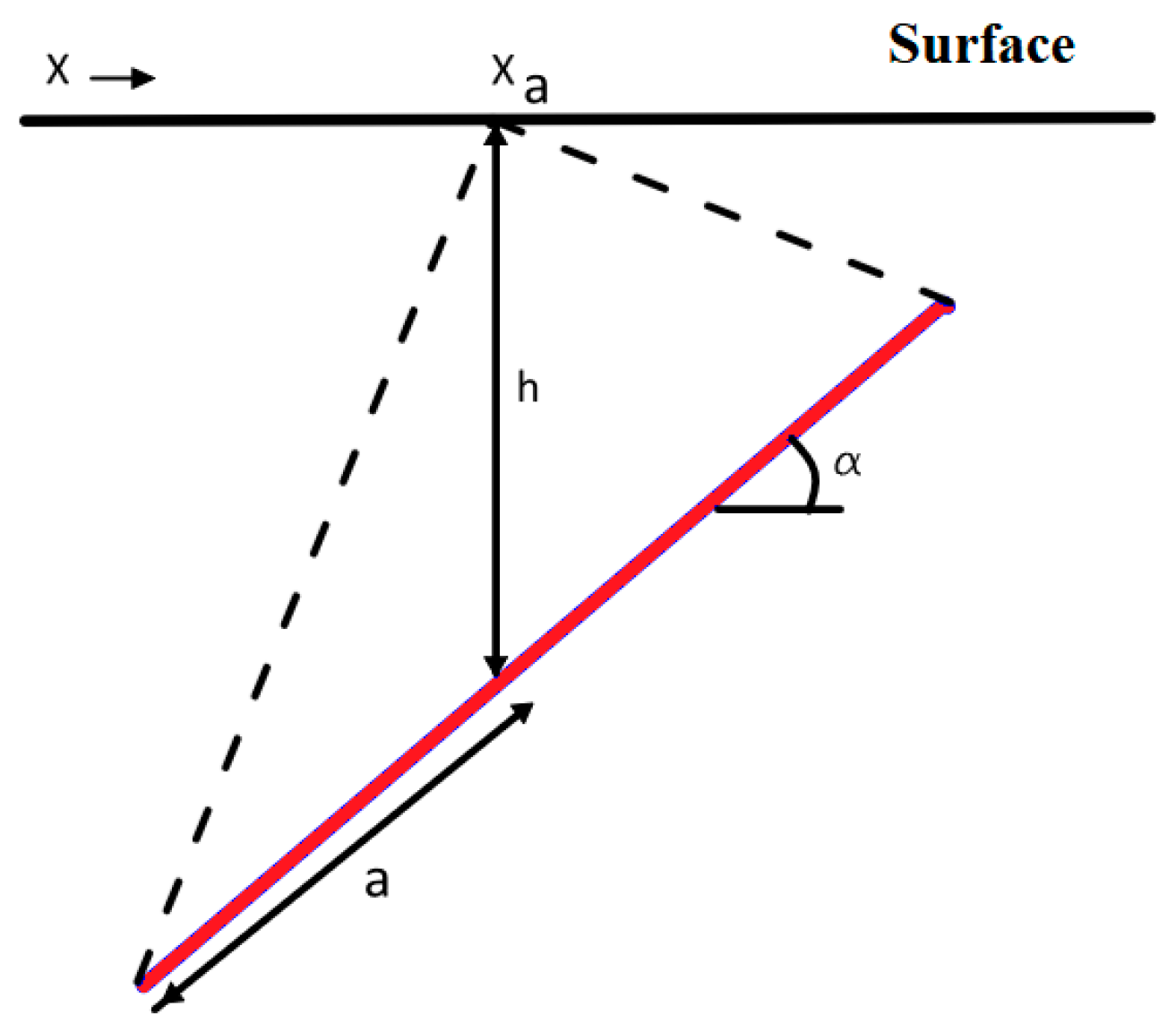
2.4.2. Data Preprocessing
- (a)
- Baseline Correction:
- (b) Noise Reduction:
2.4.3. Data Inversion with Particle Swarm Optimization (PSO)
- (a)
- Objective Function:
- (b)
- Search Space Constraints:
- (c)
- PSO Algorithm:
- Swarm Initialization: 100 particles are randomly initialized within the search space.
- Velocity and Position Update:
- where (inertia weight), (cognitive/social coefficients), and
- Termination: The algorithm terminates after 200 iterations or upon convergence (stagnation in ).
2.4.4. Validation and Performance Metrics
- (a)
- Quantitative Validation:
- -
- RMSE: Evaluates the fit between measured and modeled SP data.
- -
- Parameter Stability: Consistency of optimized parameters across independent PSO runs.
- (b)
- Noise Tolerance:Synthetic datasets with 10–20% Gaussian noise are inverted to assess robustness.
- (c)
- Visual Verification:Overlays are generated to qualitatively validate the fit.
2.4.5. Boundary Conditions
- -
- The left boundary (x = 0) represented the freshwater chamber, where freshwater was introduced.
- -
- The right boundary (x = 1) represented the saline water chamber, where saline water was added.
- -
- The interface (middle chamber) between the freshwater and saline water was modeled as the primary dynamic boundary, moving over time due to the induced hydraulic gradient and changes in water levels according to the experimental protocol in Table 1.
2.4.6. Sensitivity Calculation
- (a)
- Perturbation of Parameters: Each parameter was individually perturbed by ±1% of its original value, creating two sets of perturbed parameters: one set with an increased value (+1%) and one set with a decreased value (−1%). This perturbation was applied to each of the five parameters: K, x0, z, α, and a.
- (b)
- Objective Function Evaluation: For each perturbed set of parameters, the objective function was evaluated. The objective function compares the measured SP values with the simulated SP values and calculates the root mean squared error (RMSE) between the two. The error was computed for both the perturbed (+1%) and the reduced (−1%) parameter values.
- (c)
- Sensitivity Calculation: The sensitivity of each parameter was calculated using the following formula:
- (d)
- Parameter Sensitivity Evaluation: The sensitivity results were then evaluated for each time step. Parameters with higher sensitivity values indicate a stronger influence on the simulated SP values, whereas parameters with low sensitivity values suggest that small changes in those parameters do not significantly affect the model’s output.
3. Results
3.1. Laboratory Experimental Simulation
3.1.1. Phase 1: Initial Intrusion (0–7 h)
3.1.2. Phase 2: Equilibrium (7–17 h)
3.1.3. Phase 3: Reverse Flow (17–24 h)
3.2. Numerical Simulation and Model Validation
3.2.1. Experiment (1) (7 g/L Salt Concentration)
3.2.2. Experiment (2) (35 g/L Salt Concentration)
3.3. Sensitivity Analysis Results
3.3.1. Experiment (1) (7 g/L Salt Concentration)
3.3.2. Experiment (2) (35 g/L Salt Concentration)
4. Discussion
4.1. Results in the Framework of Previous Studies
4.2. Interpretation Based on Working Hypotheses
4.3. Broader Context and Implications
4.3.1. Advantages of the SP Method
- Cost-Effectiveness: The SP method is non-invasive and does not require extensive drilling or sampling, making it a cost-effective option for monitoring SWI. In contrast, methods like chemical sampling (used by Guo et al. [3]) are invasive, time-consuming, and require expensive laboratory analysis. For example, Guo et al. [3] relied on chemical sampling to study contaminant transport in coastal aquifers, which involves collecting and analyzing water samples—a process that is both labor-intensive and costly. The SP method eliminates these drawbacks by providing direct measurements of electrochemical gradients without the need for physical sampling.
- High Sensitivity to Ionic Transport: SP signals are highly sensitive to ionic transport and electrochemical gradients, allowing for real-time detection of saline front movement and localized charge imbalances. This sensitivity is comparable to that of the ERT (used by Folch et al. [26]), but the SP method provides continuous data without the need for complex instrumentation. Folch et al. [26] combined SP with ERT and fiber optic DTS to monitor coastal aquifers, demonstrating that while ERT offers high spatial resolution, SP provides superior temporal resolution for tracking dynamic processes like SWI.
- Real-Time Monitoring: Unlike some geophysical methods that require periodic measurements, the SP method provides continuous, real-time data, making it ideal for dynamic systems like coastal aquifers. This is a significant advantage over image analysis techniques (used by Robinson et al. [22]), which require post-processing and calibration. Robinson et al. [22] used image analysis to study SWI in laboratory setups, but their approach relies on capturing and processing images, which introduces delays and limits real-time monitoring capabilities. The SP method, on the other hand, offers immediate feedback on changes in ionic gradients, making it more suitable for real-time applications.
4.3.2. Limitations of the SP Method
- Complexity in High-Salinity Systems: While the SP method performed well in low-salinity systems, it struggled to accurately capture the sharp fluctuations in SP observed in higher salinity systems (35 g/L). This suggests that the method may be less effective in highly saline environments, where ionic gradients are steeper and more dynamic.
- Dependence on Electrochemical Properties: SP signals are highly dependent on the electrochemical properties of the porous medium and the ionic composition of the fluids [39]. This can make interpretation challenging in heterogeneous aquifers or systems with complex geochemical interactions.
4.4. Future Research Directions
5. Conclusions
Author Contributions
Funding
Data Availability Statement
Conflicts of Interest
References
- Small, C.; Nicholls, R.J. A global analysis of human settlement in coastal zones. J. Coast. Res. 2003, 19, 584–599. [Google Scholar]
- Carsel, R.F.; Parrish, R.S. Developing joint probability distributions of soil water retention characteristics. Water Resour. Res. 1988, 24, 755–769. [Google Scholar] [CrossRef]
- Guo, Q.; Zhao, Y.; Hu, Z.; Li, M. Contamination transport in the coastal unconfined aquifer under the influences of seawater intrusion and inland freshwater recharge- laboratory experiments and numerical simulations. Int. J. Environ. Res. Public Health 2021, 18, 762. [Google Scholar] [CrossRef] [PubMed]
- Bosserelle, A.L.; Morgan, L.K.; Hughes, M.W. Groundwater Rise and Associated Flooding in Coastal Settlements due to Sea-Level Rise: A Review of Processes and Methods. Earth’s Futur. 2022, 10, e2021EF002580. [Google Scholar] [CrossRef]
- Cao, X.; Guo, Q.; Liu, W. Research on the Patterns of Seawater Intrusion in Coastal Aquifers Induced by Sea Level Rise Under the Influence of Multiple Factors. Water 2024, 16, 3457. [Google Scholar] [CrossRef]
- Hauer, M.E.; Hardy, D.; Kulp, S.A.; Mueller, V.; Wrathall, D.J.; Clark, P.U. Assessing population exposure to coastal flooding due to sea level rise. Nat. Commun. 2021, 12, 6900. [Google Scholar] [CrossRef]
- Werner, A.D.; Bakker, M.; Post, V.E.; Vandenbohede, A.; Lu, C.; Ataie-Ashtiani, B.; Simmons, C.T.; Barry, D.A. Seawater intrusion processes, investigation and management: Recent advances and future challenges. Adv. Water Resour. 2013, 51, 3–26. [Google Scholar] [CrossRef]
- Zhan, Y.; Murugesan, B.; Guo, Z.; Li, H.; Chen, K.; Babovic, V.; Zheng, C. Managed aquifer recharge in island aquifer under thermal influences on the fresh-saline water interface. J. Hydrol. 2024, 638, 131496. [Google Scholar] [CrossRef]
- Neumann, B.; Vafeidis, A.T.; Zimmermann, J.; Nicholls, R.J. Future Coastal Population Growth and Exposure to Sea-Level Rise and Coastal Flooding—A Global Assessment. PLoS ONE 2015, 10, e0118571. [Google Scholar] [CrossRef]
- Dalai, C.; Dhar, A. Impact of beach face slope variation on saltwater intrusion dynamics in unconfined aquifer under tidal boundary condition. Flow Meas. Instrum. 2023, 89, 102298. [Google Scholar] [CrossRef]
- Henry, H.R. Interfaces between salt water and fresh water in coastal aquifers. US Geol. Surv. Water-Supply Paper 1964, 1613-C, 35–70. [Google Scholar]
- Voss, C.I.; Souza, W.R. Variable density flow and solute transport simulation of regional aquifers containing a narrow freshwater-saltwater transition zone. Water Resour. Res. 1987, 23, 1851–1866. [Google Scholar] [CrossRef]
- Goswami, R.R.; Clement, T.P. Laboratory-scale investigation of saltwater intrusion dynamics. Water Resour. Res. 2007, 43, W04418. [Google Scholar] [CrossRef]
- Chang, S.W.; Clement, T.P. Experimental and numerical investigation of saltwater intrusion dynamics in flux-controlled groundwater systems. Water Resour. Res. 2012, 48, W09527. [Google Scholar] [CrossRef]
- Vinogradov, J.; Jaafar, M.Z.; Jackson, M.D. Measurement of streaming potential coupling coefficient in sandstones saturated with natural and artificial brines at high salinity. J. Geophys. Res. Solid Earth 2010, 115, B12204. [Google Scholar] [CrossRef]
- Leinov, E.; Jackson, M.D. Experimental measurements of the SP response to concentration and temperature gradients in sandstones with application to subsurface geophysical monitoring. J. Geophys. Res. Solid Earth 2014, 119, 6855–6876. [Google Scholar] [CrossRef]
- Ghommem, M.; Qiu, X.; Aidagulov, G.; Abbad, M. Streaming potential measurements for downhole monitoring of reservoir fluid flows: A laboratory study. J. Pet. Sci. Eng. 2018, 161, 38–49. [Google Scholar] [CrossRef]
- El Hamidi, M.J.; Larabi, A.; Faouzi, M. Numerical modeling of saltwater intrusion in the rmel-oulad ogbane coastal aquifer (Larache, Morocco) in the climate change and sea- level rise context (2040). Water 2021, 13, 2167. [Google Scholar] [CrossRef]
- Etsias, G.; Hamill, G.A.; Benner, E.M.; Águila, J.F.; McDonnell, M.C.; Flynn, R.; Ahmed, A.A. Optimizing laboratory investigations of saline intrusion by incorporating machine learning techniques. Water 2020, 12, 2996. [Google Scholar] [CrossRef]
- Sharma, V.; Chakma, S. Experimental Study of Seawater Intrusion in Stratified Layers with Sloping Ocean–Aquifer Boundary. J. Hydrol. Eng. 2024, 29, 04024041. [Google Scholar] [CrossRef]
- Brunetti, G.F.A.; Maiolo, M.; Fallico, C.; Severino, G. Unraveling the complexities of a highly heterogeneous aquifer under convergent radial flow conditions. Eng. Comput. 2024, 40, 3115–3130. [Google Scholar] [CrossRef]
- Robinson, G.; Moutari, S.; Ahmed, A.A.; Hamill, G.A. An Advanced Calibration Method for Image Analysis in Laboratory-Scale Seawater Intrusion Problems. Water Resour. Manag. 2018, 32, 3087–3102. [Google Scholar] [CrossRef]
- Martínez-Pérez, L.; Luquot, L.; Carrera, J.; Marazuela, M.A.; Goyetche, T.; Pool, M.; Palacios, A.; Bellmunt, F.; Ledo, J.; Ferrer, N.; et al. A multidisciplinary approach to characterizing coastal alluvial aquifers to improve understanding of seawater intrusion and submarine groundwater discharge. J. Hydrol. 2022, 607, 127510. [Google Scholar] [CrossRef]
- Sandberg, S.K.; Slater, L.D.; Versteeg, R. An integrated geophysical investigation of the hydrogeology of an anisotropic unconfined aquifer. J. Hydrol. 2002, 267, 227–243. [Google Scholar] [CrossRef]
- Morgan, L.K.; Werner, A.D. A national inventory of seawater intrusion vulnerability for Australia. J. Hydrol. Reg. Stud. 2015, 4, 686–698. [Google Scholar] [CrossRef]
- Folch, A.; del Val, L.; Luquot, L.; Martínez-Pérez, L.; Bellmunt, F.; Le Lay, H.; Rodellas, V.; Ferrer, N.; Palacios, A.; Fernández, S.; et al. Combining fiber optic DTS, cross-hole ERT and time-lapse induction logging to characterize and monitor a coastal aquifer. J. Hydrol. 2020, 588, 125050. [Google Scholar] [CrossRef]
- Revil, A.; Trolard, F.; Bourrié, G.; Castermant, J.; Jardani, A.; Mendonça, C.A. Ionic contribution to the self-potential signals associated with a redox front. J. Contam. Hydrol. 2009, 109, 27–39. [Google Scholar] [CrossRef]
- Graham, M.T.; MacAllister, D.J.; Vinogradov, J.; Jackson, M.D.; Butler, A.P. Self-Potential as a Predictor of Seawater Intrusion in Coastal Groundwater Boreholes. Water Resour. Res. 2018, 54, 6055–6071. [Google Scholar] [CrossRef]
- Crestani, E.; Camporese, M.; Belluco, E.; Bouchedda, A.; Gloaguen, E.; Salandin, P. Large-Scale Physical Modeling of Salt-Water Intrusion. Water 2022, 14, 1183. [Google Scholar] [CrossRef]
- Stoeckl, L.; Houben, G. How to conduct variable-density sand tank experiments: Practical hints and tips. Hydrogeol. J. 2023, 31, 1353–1370. [Google Scholar] [CrossRef]
- Yu, X.; Xin, P.; Lu, C. Seawater intrusion and retreat in tidally-affected unconfined aquifers: Laboratory experiments and numerical simulations. Adv. Water Resour. 2019, 132, 103393. [Google Scholar] [CrossRef]
- Sharma, B.; Bhattacharjya, R.K. Behaviour of contaminant transport in unconfined coastal aquifer: An experimental evaluation. J. Earth Syst. Sci. 2020, 129, 140. [Google Scholar] [CrossRef]
- Santoso, B.; Hendarmawan; Rosandi, Y. Study of groundwater flow patterns in landslide prone areas using the Self Potential Method. IOP Conf. Ser. Earth Environ. Sci. 2024, 1373, 012012. [Google Scholar] [CrossRef]
- Kniebusch, M.; Meier, H.E.M.; Radtke, H. Changing Salinity Gradients in the Baltic Sea As a Consequence of Altered Freshwater Budgets. Geophys. Res. Lett. 2019, 46, 9739–9747. [Google Scholar] [CrossRef]
- Schlesinger, W.H.; Bernhardt, E.S. The Oceans. In Biogeochemistry; Elsevier: Amsterdam, The Netherlands, 2020; pp. 361–429. [Google Scholar]
- Jougnot, D.; Linde, N.; Haarder, E.B.; Looms, M.C. Monitoring of saline tracer movement with vertically distributed self-potential measurements at the HOBE agricultural test site, Voulund, Denmark. J. Hydrol. 2015, 521, 314–327. [Google Scholar] [CrossRef]
- Cui, Y.-A.; Zhu, X.-X.; Chen, Z.-X.; Liu, J.-W.; Liu, J.-X. Performance evaluation for intelligent optimization algorithms in self-potential data inversion. J. Cent. South Univ. 2016, 23, 2659–2668. [Google Scholar] [CrossRef]
- El-Kaliouby, H.M.; Al-Garni, M.A. Inversion of self-potential anomalies caused by 2D inclined sheets using neural networks. J. Geophys. Eng. 2009, 6, 29–34. [Google Scholar] [CrossRef]
- Ferziger, J.H.; Perić, M.; Street, R.L. Computational Methods for Fluid Dynamics; Springer: Berlin/Heidelberg, Germany; New York, NY, USA, 2002. [Google Scholar]
- Meyer, R.; Engesgaard, P.; Sonnenborg, T.O. Origin and Dynamics of Saltwater Intrusion in a Regional Aquifer: Combining 3-D Saltwater Modeling with Geophysical and Geochemical Data. Water Resour. Res. 2019, 55, 1792–1813. [Google Scholar] [CrossRef]
- Costall, A.; Harris, B.; Pigois, J.P. Electrical Resistivity Imaging and the Saline Water Interface in High-Quality Coastal Aquifers. Surv. Geophys. 2018, 39, 753–816. [Google Scholar] [CrossRef]
- Emara, S.R.; Armanuos, A.M.; Zeidan, B.A.; Gado, T.A. Numerical investigation of mixed physical barriers for saltwater removal in coastal heterogeneous aquifers. Environ. Sci. Pollut. Res. 2024, 31, 4826–4847. [Google Scholar] [CrossRef]
- Kuan, W.K.; Jin, G.Q.; Xin, P.; Robinson, C.; Gibbes, B.; Li, L. Tidal influence on seawater intrusion in unconfined coastal aquifers. Water Resour. Res. 2012, 48, 2502. [Google Scholar] [CrossRef]
- Xu, X.; Xiong, G.; Chen, G.; Fu, T.; Yu, H.; Wu, J.; Liu, W.; Su, Q.; Wang, Y.; Liu, S.; et al. Characteristics of coastal aquifer contamination by seawater intrusion and anthropogenic activities in the coastal areas of the Bohai Sea, eastern China. J. Asian Earth Sci. 2021, 217, 104830. [Google Scholar] [CrossRef]
- Kumar, P.; Tiwari, P.; Biswas, A.; Acharya, T. Geophysical investigation for seawater intrusion in the high-quality coastal aquifers of India: A review. Environ. Sci. Pollut. Res. 2023, 30, 9127–9163. [Google Scholar]




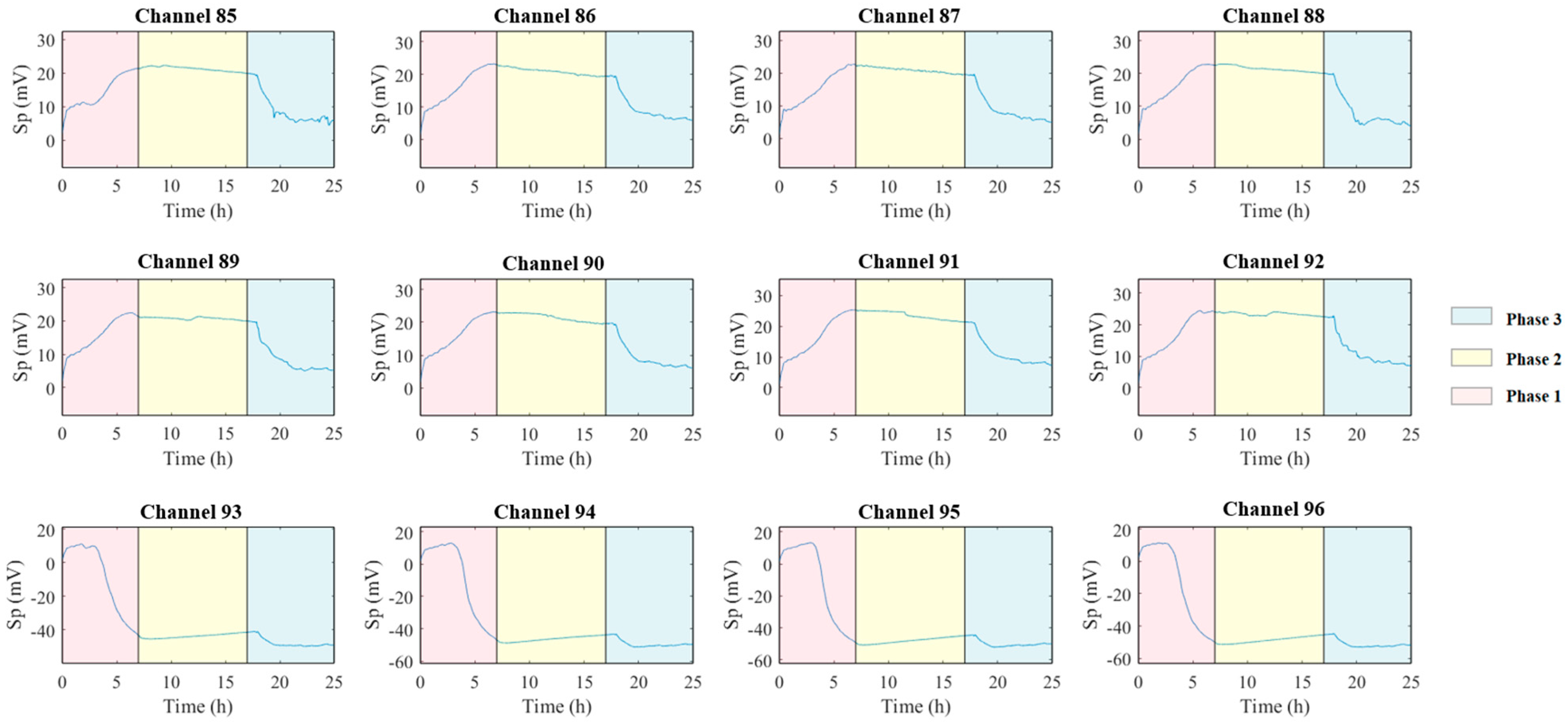
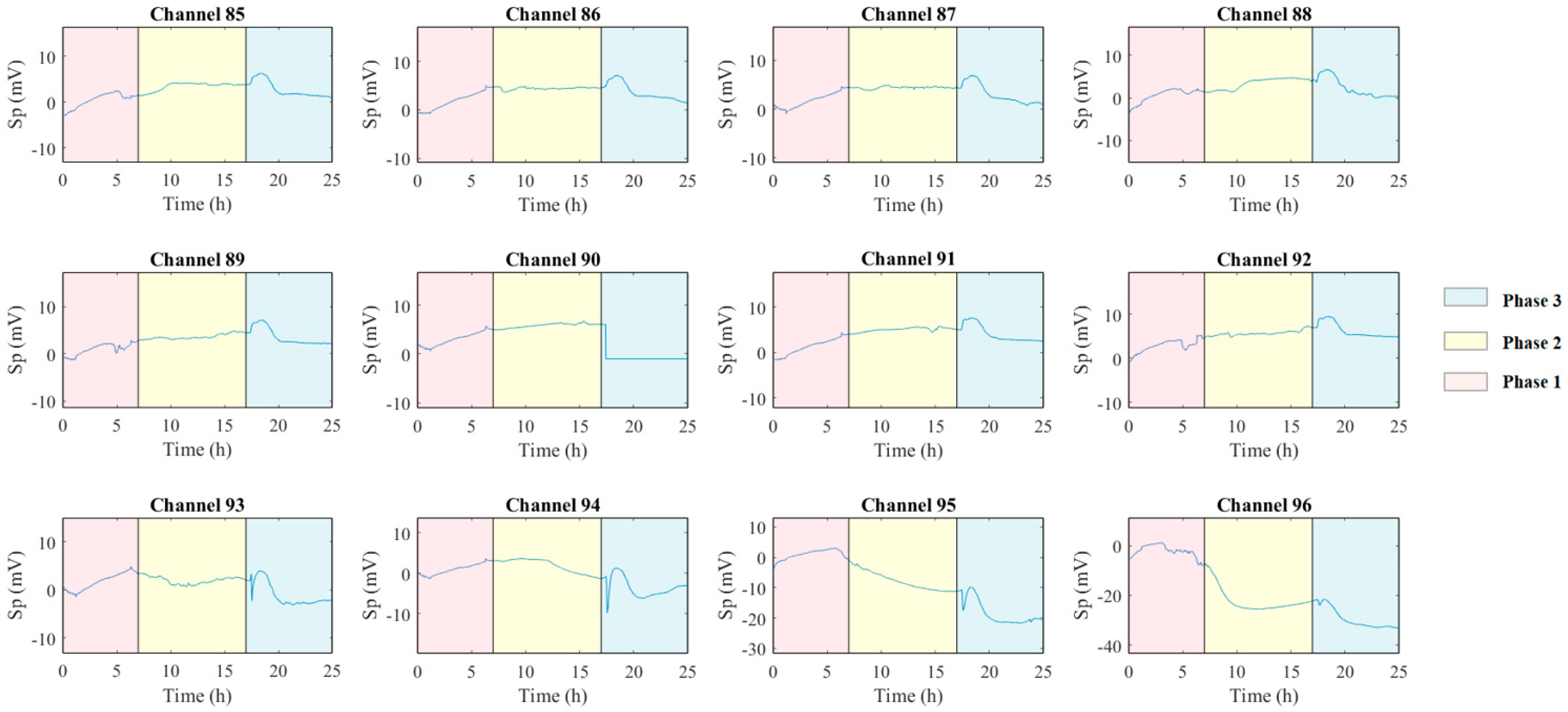
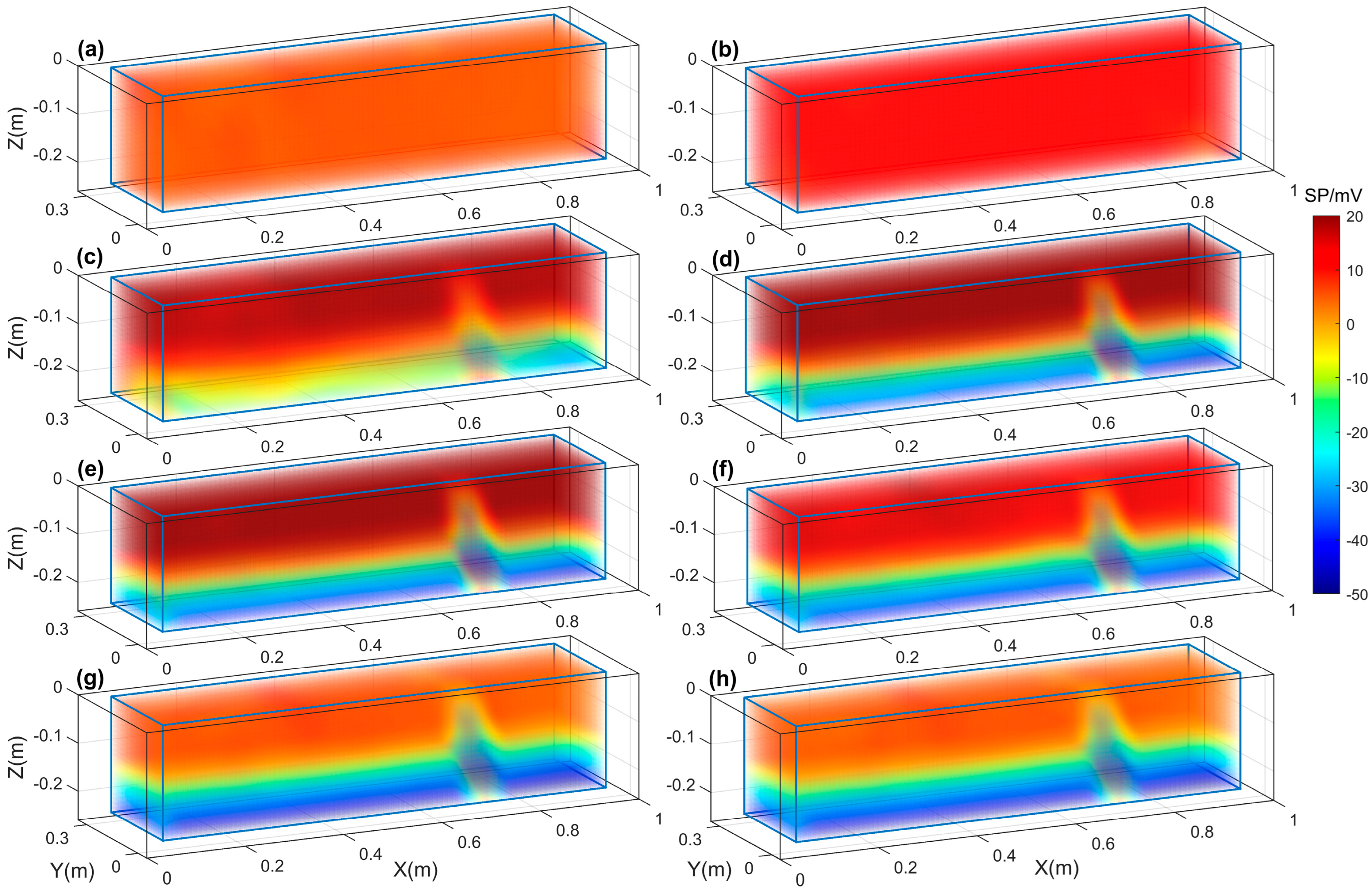
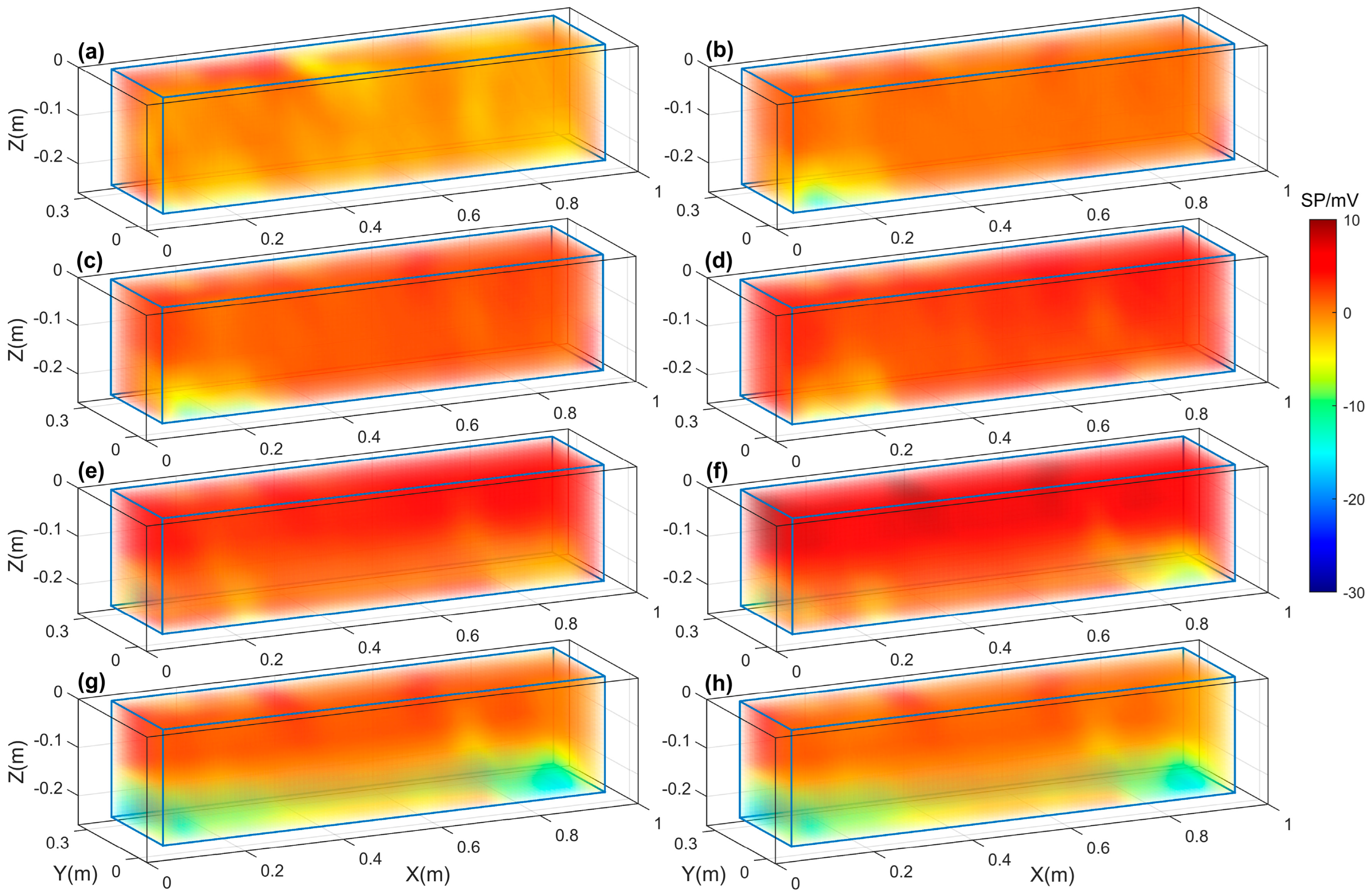


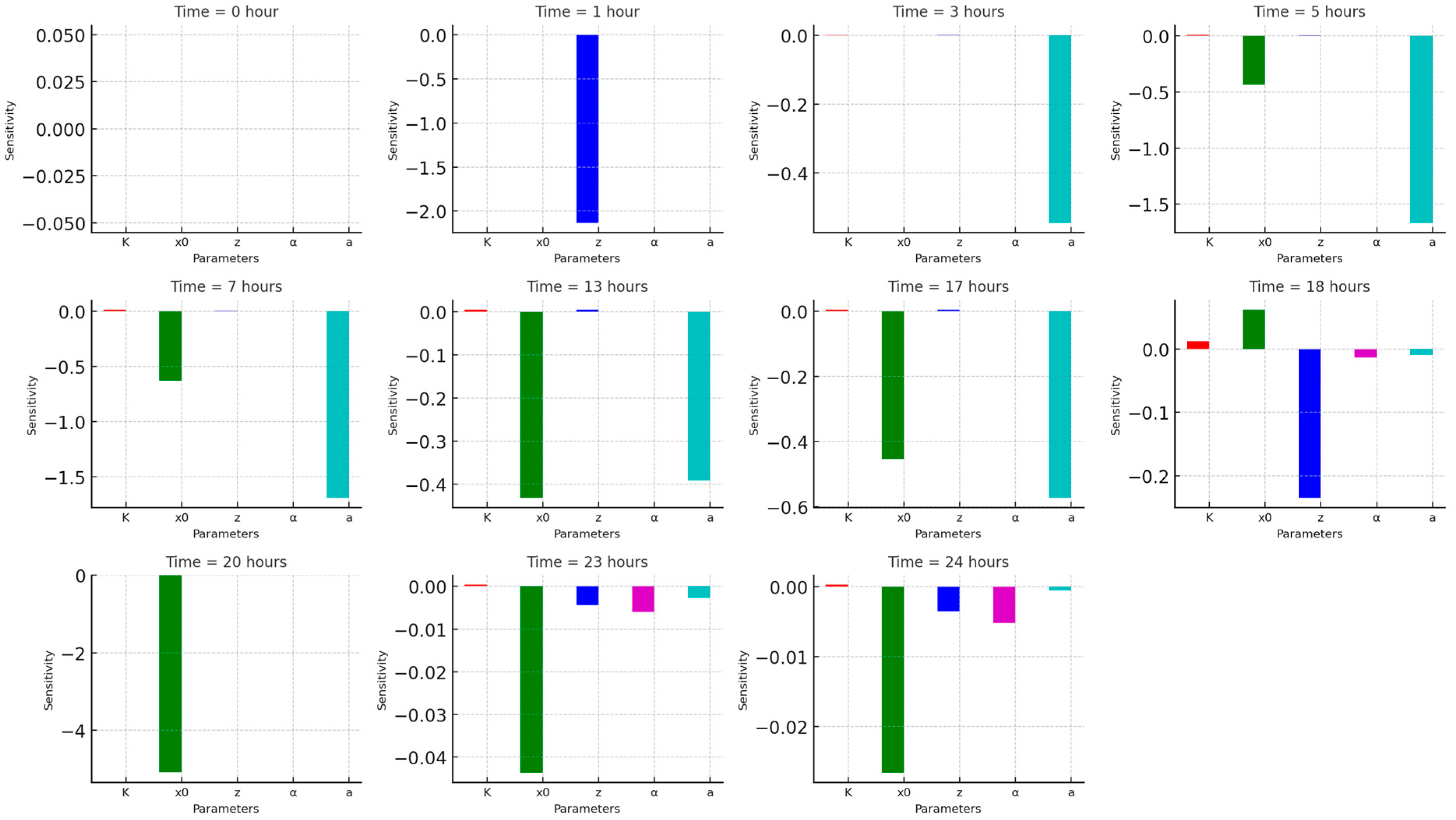

| Phase | Duration | Hydraulic Conditions | Objective |
|---|---|---|---|
| 1 | 0–7 h | Saline water: 47.5 cm Freshwater: 46 cm Interface: 45 cm | Induce right-to-left SWI under a 1.5 cm hydraulic gradient. |
| 2 | 7–17 h | All chambers equilibrated to 45 cm | Observe steady-state equilibrium and SWI stabilization. |
| 3 | 17–24 h | Saline water: 46 cm Freshwater: 47.5 cm Interface: 45 cm | Reverse flow direction (left-to-right) to analyze SWI retreat dynamics. |
| Component | Specification | Purpose |
|---|---|---|
| Central chamber | Homogeneous silica sand (0.425 mm grain size, 39% porosity) | Simulate confined aquifer with controlled hydraulic properties. |
| Geotextile/mesh barriers (sand filter) | 0.1 mm mesh screens + geotextile membranes | Prevent sediment migration between chambers. |
| Overflow system | Adjustable vertical overflow with drainage pipes | Maintain precise hydraulic heads and evacuate excess water. |
| Saline water tracer | Red dye (non-reactive) | Visualize SWI progression and spatial distribution. |
| SP monitoring | SP electrodes + data logger | Measure electrical potentials linked to ionic transport during SWI. |
Disclaimer/Publisher’s Note: The statements, opinions and data contained in all publications are solely those of the individual author(s) and contributor(s) and not of MDPI and/or the editor(s). MDPI and/or the editor(s) disclaim responsibility for any injury to people or property resulting from any ideas, methods, instructions or products referred to in the content. |
© 2025 by the authors. Licensee MDPI, Basel, Switzerland. This article is an open access article distributed under the terms and conditions of the Creative Commons Attribution (CC BY) license (https://creativecommons.org/licenses/by/4.0/).
Share and Cite
Fanidi, M.; Cui, Y.-A.; Xie, J.; Khalil, A.A.; Shahzad, S.M. Modeling and Validating Saltwater Intrusion Dynamics by Self-Potential: A Laboratory Perspective. Water 2025, 17, 941. https://doi.org/10.3390/w17070941
Fanidi M, Cui Y-A, Xie J, Khalil AA, Shahzad SM. Modeling and Validating Saltwater Intrusion Dynamics by Self-Potential: A Laboratory Perspective. Water. 2025; 17(7):941. https://doi.org/10.3390/w17070941
Chicago/Turabian StyleFanidi, Meryem, Yi-An Cui, Jing Xie, Ahmed Abdelreheem Khalil, and Syed Muzyan Shahzad. 2025. "Modeling and Validating Saltwater Intrusion Dynamics by Self-Potential: A Laboratory Perspective" Water 17, no. 7: 941. https://doi.org/10.3390/w17070941
APA StyleFanidi, M., Cui, Y.-A., Xie, J., Khalil, A. A., & Shahzad, S. M. (2025). Modeling and Validating Saltwater Intrusion Dynamics by Self-Potential: A Laboratory Perspective. Water, 17(7), 941. https://doi.org/10.3390/w17070941







